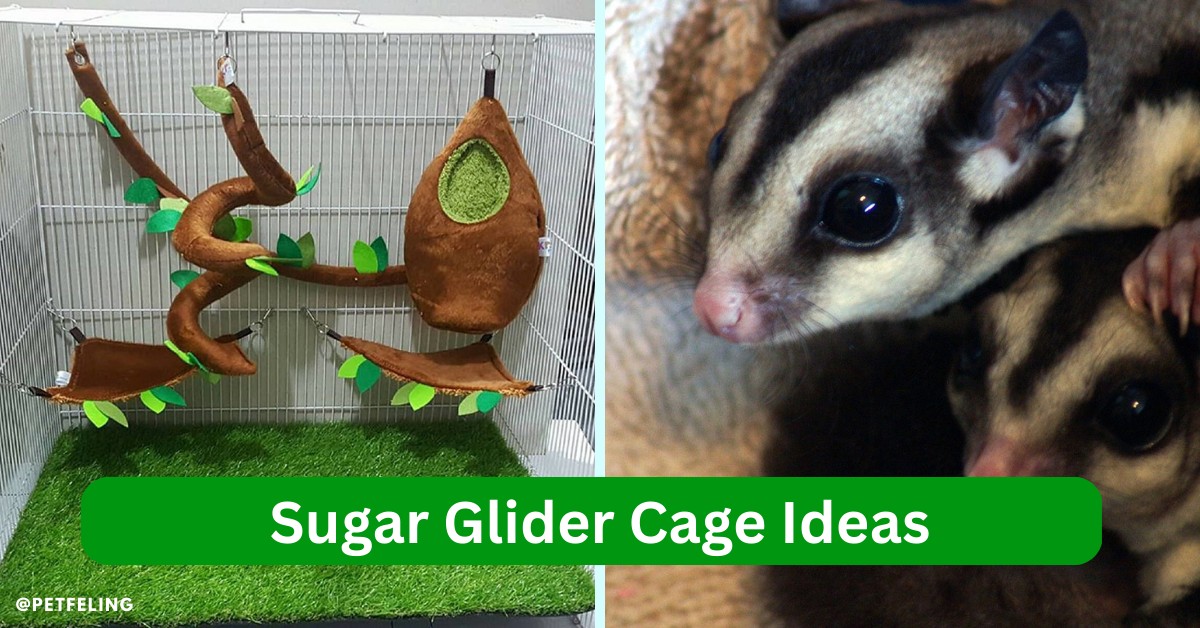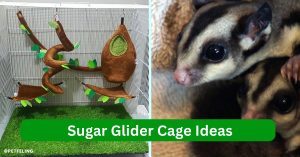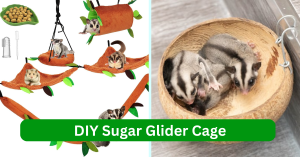Due to their high level of activity, sugar gliders require a large cage. The amount of vertical space is more crucial than the cage’s square footage because they want to climb and jump. A pair of sugar gliders should have a cage that is 24 inches deep, 24 inches wide, and 36 inches tall. Larger is always preferable, keeping in mind that the gliders need height. The wires should be spaced no more than 1/2 inch apart. It shouldn’t matter if the bars are horizontal or vertical. According to some businesses, sugar glider cages must have horizontal bars since gliders cannot use vertical bars or, if they did, would suffer foot injuries.
This information is entirely untrue and is being exploited as a marketing gimmick to sell their particular horizontally wired cages. Over the past 10+ years, Exotic Nutrition has sold thousands of cages, all of which include primarily vertical wiring, with no concerns or complaints from glider owners. Because they are expert climbers, sugar gliders have no trouble at all climbing up, down, or around on vertical wires. Some businesses assert that because joeys are not at ease in huge cages when they are young, you should buy a small beginning cage or travel cage for them first and a larger one later. This is inaccurate as well, and it’s just a sales tactic to persuade you to buy more cages.
Shelves can be added to cages that already have them, which is excellent. In our cage accessory area, shelves are available separately. It is challenging to acquire the ideal housing in a neighborhood pet shop because the majority of commercial cages are not offered in the required Sugar Glider dimensions. Because gliders can occasionally learn how to open latches and let themselves out, the cage’s latch needs to be secure. Avoid sugar glider cages that don’t have latching doors, which are sold as such. Keep in mind to set the cage in a visible location in your house that is also out of direct sunlight and away from drafts. They function best at temperatures between 70 and 90 °F, which is a little bit warmer than room temperature.
Setting up Sugar Glider Cage
Step 1: Choose the Right Cage for Your Sugar Gliders
Their size is the most important factor to take into account when selecting their habitat. Depending on how many sugar gliders you have, the size of the cage will change. Of course, the cage must be larger as the number of sugar gliders increases. Check out the bird cages and finch cages, and be sure to look into the sizes that are offered. Then, carefully choose the one with thoughtful bar spacing to prevent your furry buddies from escaping without your knowledge.
Step 2: Find the Perfect Spot for Your Cage
The next thing you should do is choose a suitable area to put the cage. The cage should be placed in an easily accessible area that is out of direct sunlight, according to experts. Additionally, you want to set your pet’s glider cage in a secure area. The environment should be: consistently between 18 and 24 degrees Celsius (65 and 75 degrees Fahrenheit). Placed far from your home’s entrances, including its doors, windows, and exhausts
You can add caster wheels to your sugar glider cage to make it movable and prevent it from being kept in one place.
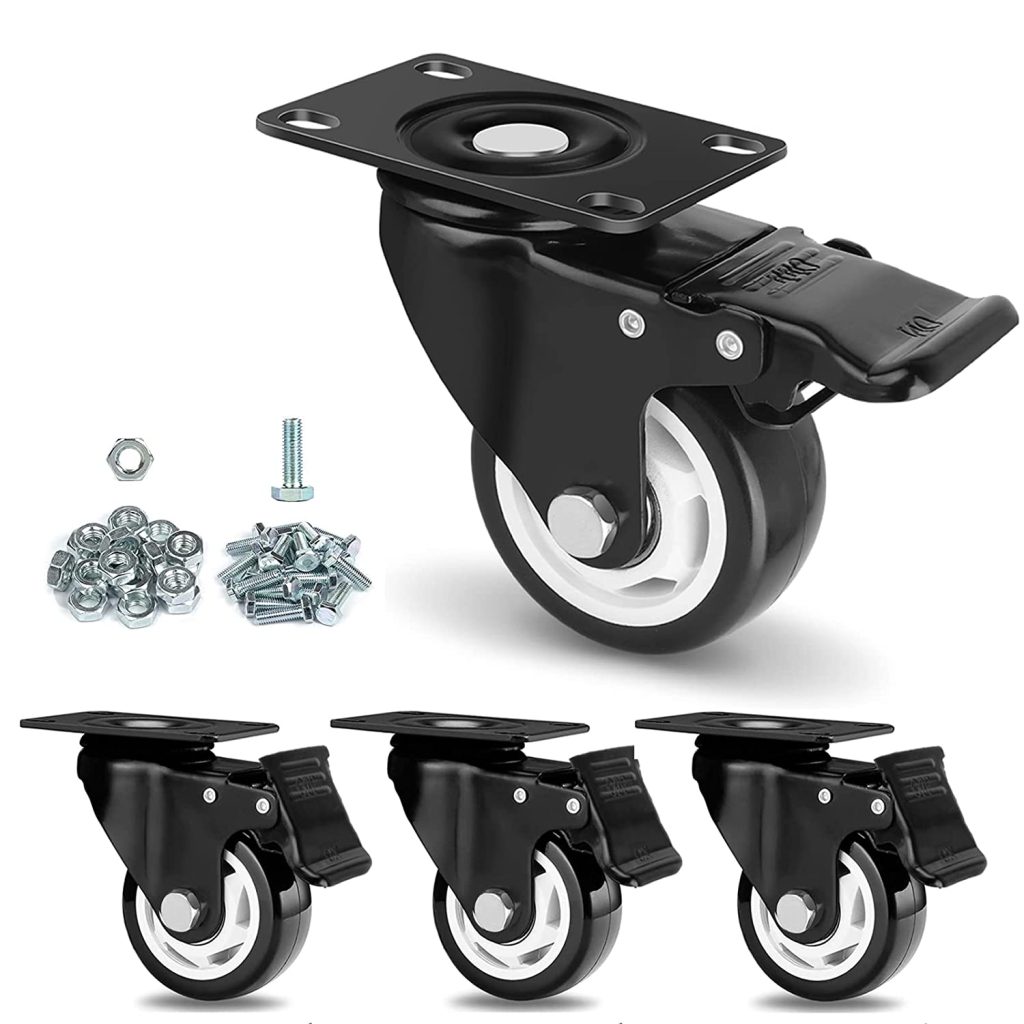
Step 3: Gather the Needed Things for the Cage
After that, compile the items from the list above. everything, even those poop trays, yes! Installing and setting them up within the cage should wait while you plan it out. As a result, get everything ready, including the nest boxes or pouches, the bedding material, the toys, exercise wheels, ropes, food dishes, water bottles, water dishes, bedding, and pull-out dropping trays. Keep them somewhere you can easily see them all. This is to help you remain calm before installing them.
Step 4: Set Up the Nest Box/Nest Pouch
The nest box pouches will then begin to be installed as their sleeping chambers. Don’t get too caught up in the details; nest boxes can be made from materials as basic as plastic, wicker, and even untreated wood. It can be a strong cloth that you suspend from the top of the cage for nest pouches. Although it’s nothing to worry about, it’s still a good idea to invest in these things. Being ready won’t hurt because you never know when you’ll buy another furry pet. The nest box needs to be placed across from where the pull-out tray will go, which is easy to do in the cage.
They won’t unintentionally ingest their own feces because of this. It can also be placed next to the food and water bowls so that they can get to it more easily. Putting the nest pouch there. The nest pouches, on the other hand, can be hung virtually anywhere in the cage. Keep the distance between installations of more than two which is not too far or near. In case your pals decide to play with the pouches, make sure they won’t tangle with one another.
Step 5: Lay the Bedding Materials
The majority of cages for sugar gliders are huge finch or bird cages. Thus, a wire bottom would serve as the base. Install the bedding material at the base or bottom to ensure that your pets won’t make a mess. This can be as easy as using an absorbent substrate to soak up moisture and capture falling materials inside the cage.
There is no need for you to install bedding if your cage already has it.
Step 6: Install the Pull-Out Droppings Tray
Any form of cage must include a “poop tray,” as we pet owners refer to it. All of the trash will be gathered there.
Typically, the mattress material matches the pull-out tray. It completes the cage as an addition. If the cage you ordered doesn’t yet have a pull-out tray, you can buy one separately. Since mine was missing one, I installed the pull-out tray just beneath the cage’s base.
Step 7: Add Bird Toys and Other Accessories
Finally, include the accessories and toys that will keep your pets occupied. Variations on the toys you’ll include are possible. Leashes, open-ended pouches, chew toys, bells, noisy squeak toys, and a lot more are examples of how basic they can be. In addition to traditional toys, it would be beneficial to have additional sources of entertainment. These also include soft fabric balls, exercise wheels, ladders, ropes, and swings. Adding branches, stems, and other woody elements is also advised by some experts. This fosters a sense of comfort with your pet. Once finished, you may relax knowing that your social animals have a place to live. When you observe them taking time to enjoy their vertical space, you’ll know that you were successful in setting it up.
Check out our next article on DIY Sugar Glider cages
What Do Sugar Gliders Need in Their Cage?
Bird toys
As far as we know, sugar gliders are communicative and social creatures. When they can get their small hands on something to play with, they will. Make sure you include toys for sugar gliders, such as bird toys, kid’s toys, and a variety of other items you think will work.
Exercise Wheels
In addition to animal toys, adding exercise wheels would be fantastic. For us, it’s for them to keep those legs and joints healthy, but in their minds, it’s just another kind of toy. Inside their cages, you may add the exercise wheels that hamsters and other rodents use.
Bedding and Cage Liners
Depending on how many you have, you should clean out the shavings in the bottom of the cage once or twice a week, or more frequently if necessary.
Water Bottle or Water Dishes
It’s also crucial to keep water bottles inside the cage. Having one is just as vital as giving them dishes or a container to put their food in.
Furnishings and Toys
Sugar gliders are social creatures. The number of toys in their cage should be sufficient to encourage attention, curiosity, and mobility. Frequently rearrange the cage. Rearranging the toys and décor in your pet’s cage on a regular basis is the simplest approach to livening up his environment. And when you clean his cage, that’s the easiest time to reorganize it. Moving a shelf to the opposite side of the cage can be as easy as that, or it can be as difficult as completely rearranging everything in your pet’s house.
Sugar gliders should be able to climb and hop on a variety of branches to get some exercise. Fresh branches are welcome, but make sure they are from non-toxic plants like manzanita branches and are free of pesticides and fertilizers. Additionally, stay away from coniferous tree branches like those from pine and cedar since they create sticky sap. Ladders and ropes can offer more climbing chances. Toys made of wood are suitable for sugar gliders (check our toy department). Gliders enjoy spending time up high in the cage; therefore, toys placed there will be most appreciated. It is better to stay away from cloth toys, or at the very least, check them frequently for any loose threads that could entangle the gliders or be ingested.
If you give young gliders an exercise wheel, it might be a tremendous hit and provide lots of opportunities for exercise. To prevent legs and tails from becoming tangled, it is advisable to use a larger wheel with a solid surface (we recommend the Silent Runner 12-inch). Additionally, some people utilize the transparent plastic globes (also known as “critter crawlers”) that you can put your pet in and allow them to roam the house.
Food Dishes
The simplest option is probably to use stainless steel dishes that hang from the cage’s side. They must be appropriately sized—not so big that gliders can climb inside and contaminate them. Water can be given in a bottle, but if the gliders are not accustomed to drinking from one, you should provide them access to another clip-on water dish until you are certain that they are consistently drinking from the bottle.
What Makes a Good Sugar Glider Cage?
A cage that is situated properly and has everything its companions require is what many people would regard as a decent sugar glider cage. These would include:
- Toy animals
- Cloth Ropes and Balls
- Nest Pouches or Boxes
- Food Items
- Water Utensils
Most new sugar glider owners are perplexed by how to make their pets’ homes entertaining and enjoyable. In light of the aforementioned considerations, you can say with absolute certainty that your sugar glider cage is distinct in a good way.
Sugar Glider Cage sets are available on Amazon
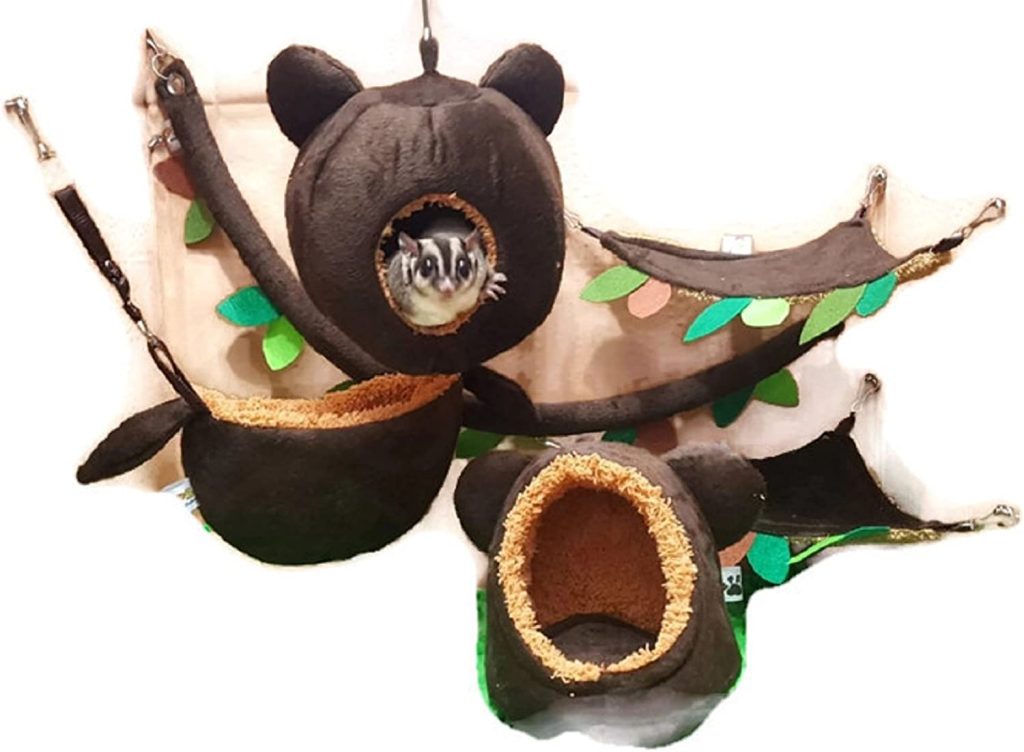
The Junle Bear Sugar Glider Cage is adorable. Your sugar glider will seem even cuter thanks to its jungle bear motif. But if the items weren’t sturdy, these adorable patterns wouldn’t really matter. Fortunately, there’s no need to worry because everything in this set was created from sturdy velvet fabric. These tiny sugar glider cage accessories should last for a very long time in your life. It more than justifies the costly set’s price tag. To stop Sugar Glider or other small creatures from nailing it, the fabric is velvet.
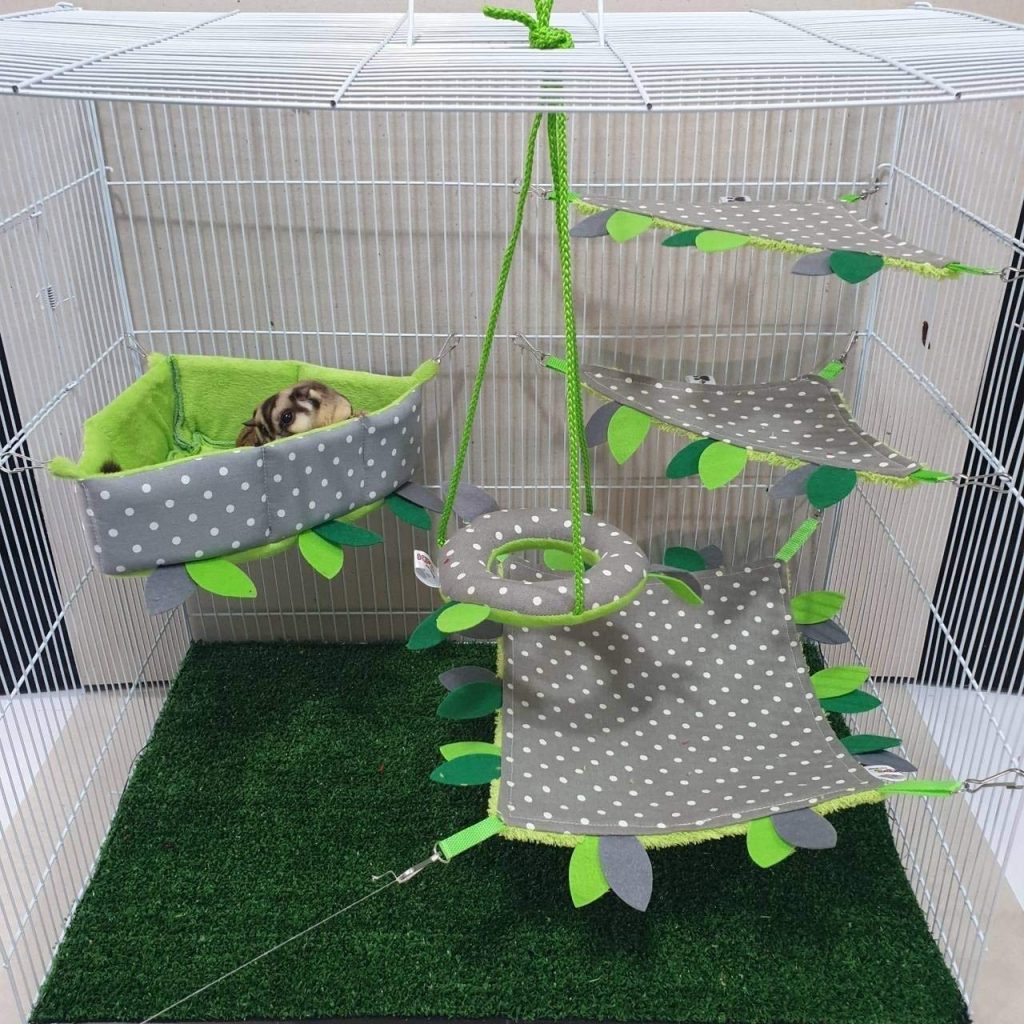
The Sugar Glider Cage Nest Set from KPS is a good choice if you want something more understated. The green/gray polka dot pattern on this item should easily integrate into any cage. Not to be overlooked are the secure stitching and tough velvet material that keep your glider snug and safe. With its demonstrated capacity to provide a variety of comfy resting areas, this 5-piece set accomplishes everything correctly.
Even more so, KPS stressed the need of making sure your glider’s nails don’t catch on the cloth. To stop Sugar Glider or other small creatures from nailing it, the fabric is velvet. Your pet’s safety is ensured by hidden seams. constructed using stitching and materials that are safe for sugar gliders. Make your little pet’s cage a fun place to hang it. Mesh laundry bags for machine washing Air is the only way to dry. These sets are built to endure longer than conventional cage sets since they are made of sturdy plastic mesh and have fleece-covered edges.
Conclusion
Large enough to allow for climbing and jumping, sugar glider cages should also have branches, toys, and a nest box for sleeping. To avoid gnawing and rusting, the cage should also be constructed of a sturdy material, such as stainless steel. It’s also advised to provide the sugar glider with access to UVB lighting and keep the cage in a space with a constant temperature. Overall, in order to provide a cozy and healthy habitat, it’s critical to make sure a sugar glider cage is well-suited to the animal’s needs.
FAQ Section
Which Toys Do Sugar Gliders Enjoy?
A range of animal toys, including chew toys, squeaky toys, and fun balls, are beloved by sugar gliders. For them, you can also include sturdy ropes, ladders, and exercise wheels, as well as stems and branches.
How frequently should your sugar glider cage be cleaned?
Cleaning the cages at least once a week is the ideal habit to form. Cleaning the bedding, removing some food from the toys, and emptying the drop-off dish are all examples of this.
